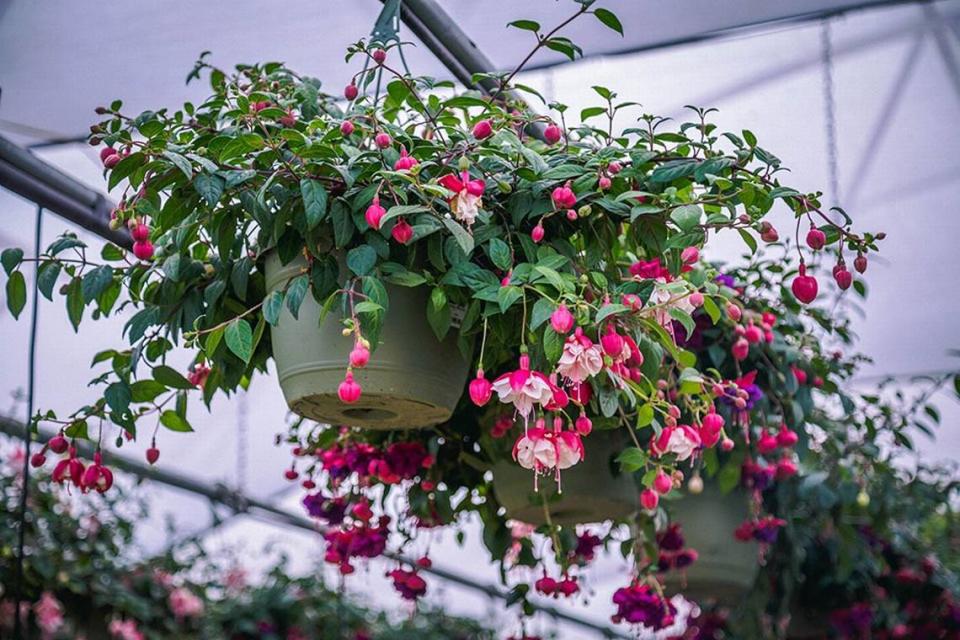Healthy ways to attract hummingbirds without a feeder than needs constant cleaning
The end of June is a good time to fertilize your pots and hanging baskets as the warmer nights will encourage plenty of new growth on annual plants.
If your petunias are growing thin and leggy, pinch out the top one fourth of the plant to encourage more branching and fuller plants.
Deadhead or remove the faded blooms from fuchsia baskets, making sure to remove the green berry that sits just behind the faded fuchsia petals. If this berry is allowed to ripen and turn purple, it will start forming seeds and take energy and flower production away from the fuchsia.
Don’t see many hummingbirds this summer? Instead of a hummingbird feeder that must be cleaned every day to keep it free of harmful bacteria, consider adding some hummingbird attracting plants to your garden now. Flower nectar is more nutritious and much safer for our hummingbirds than sugar water from a plastic feeder. Yes, they love sugar water — but like little kids begging for candy, what they love to eat may not be the best thing for them.
Hanging basket plants that feed hummingbirds
Angel Wing Begonia or Begonia boliviensis: These are the begonias with small flowers with leaves more pointed and shaped like an angel’s wing. Common names include Million Kisses, Bonfire begonia, Bossa Nova and Santa Cruz. The good news is that in our region these prolific begonia bloomers will thrive in sun or shade and are very forgiving to beginning gardeners. Enjoy them in mixed containers or all by themselves for dependable color that will last until October. Some local gardeners even say they have been able to overwinter the angel wing begonias and enjoy them for several years.
Petunias and Calibrachoa: Big petunias, mini petunias, super petunias and the compact calibrachoas all have the funnel-shaped blooms that draw in the hummers. Look for bright colors like red and orange to really draw in new birds. All these members of the petunia family do best with plenty of sunshine and fertilizer.

Fuchsias: The traditional hanging basket of fuchsias is how most new gardeners first meet hummingbirds up close. As a bonus, this hanging basket will flower even in the shade of a north-facing patio or porch. Just don’t let your fuchsias dry out and remember to deadhead to remove the faded blooms and the berry behind them.
Lantana: I have learned to love lantana after growing this annual in a hot spot of my California garden. Here in Western Washington, you must pick a spot with reflected heat from a west- or south-facing building to keep the sun-loving lantana happy. Lantana is drought resistant and comes in tropical colors.
Salvia: The spiky form of salvia are often used in garden beds, but mixed into hanging baskets they add an unexpected texture and are a hummingbird magnet. Salvia can be found at local nurseries in some new shades of purple, rose and deep pink.
Don’t forget early spring flowering plants
After a long flight home, who wouldn’t want to hang out where there is plenty of fresh food and water? Add some spring flowering perennials to your garden now to provide healthy plant nectar next spring for winter-weary hummingbirds. A buffet of spring bloomers is one way to bribe the hummingbirds into making their adorable moss and spider web nests in your garden.
First to bloom are the crocus, followed by pulmonarias or lungwarts, which are low-growing groundcovers for shaded areas that look great under the skirts of rhododendrons and azaleas. Add leaf mold or compost to the planting hole for these woodland plants.
As companion flowers in the shade garden, think bleeding hearts that are now available with golden foliage (Bleeding Heart Gold Heart). Or if you have a large wooded area, consider the native bleeding heart that will spread with underground roots. In late spring, our native foxgloves and columbine will not only add taller color but a more upright form to a mixed flower garden.
When it comes to planting flowers over filling feeders for hummingbirds, the flowers will always win as the healthiest choice for the tiny birds.
Marianne Binetti has a degree in horticulture from Washington State University and is the author of several books. Reach her at binettigarden.com.


